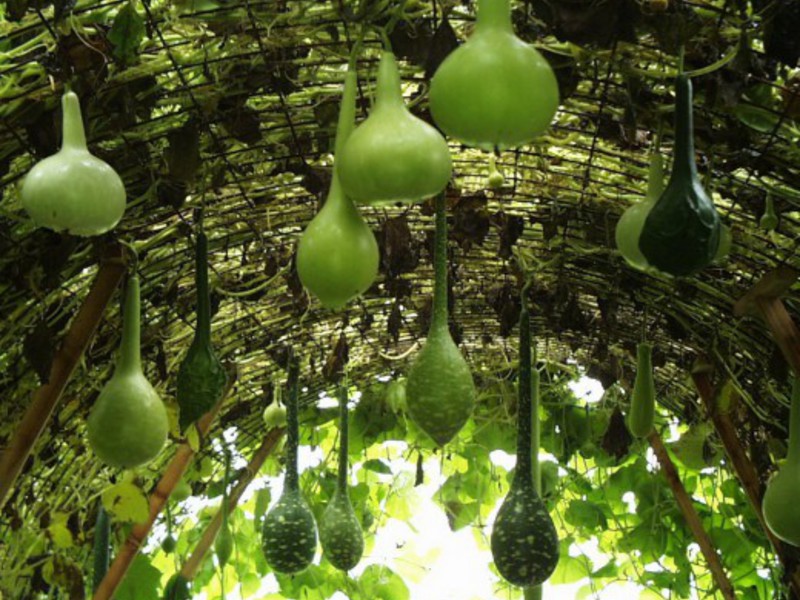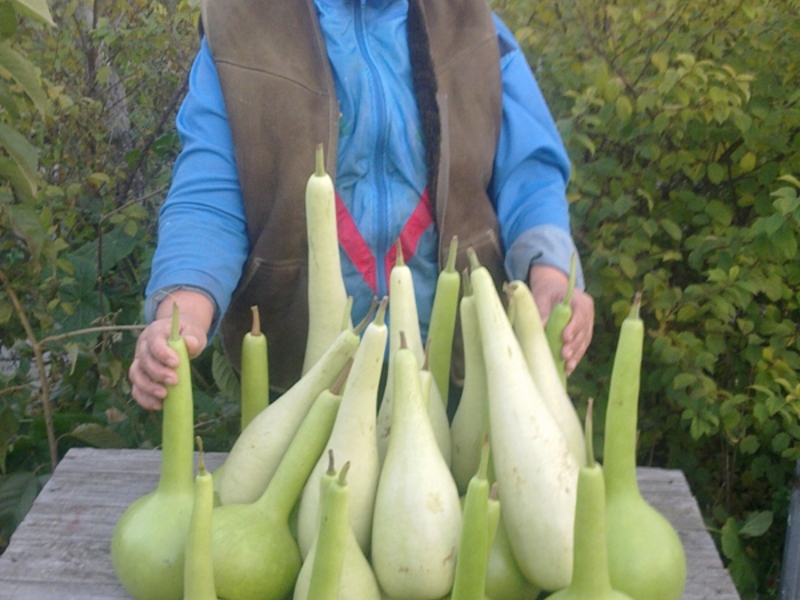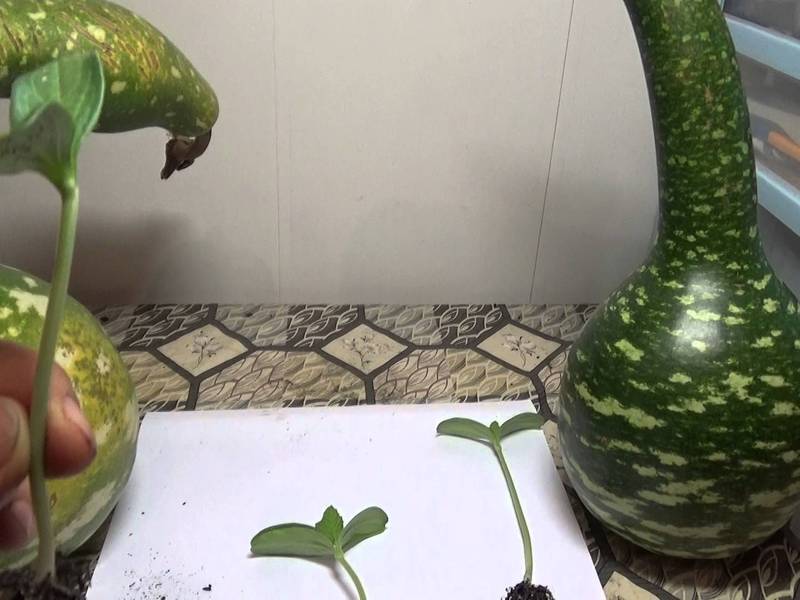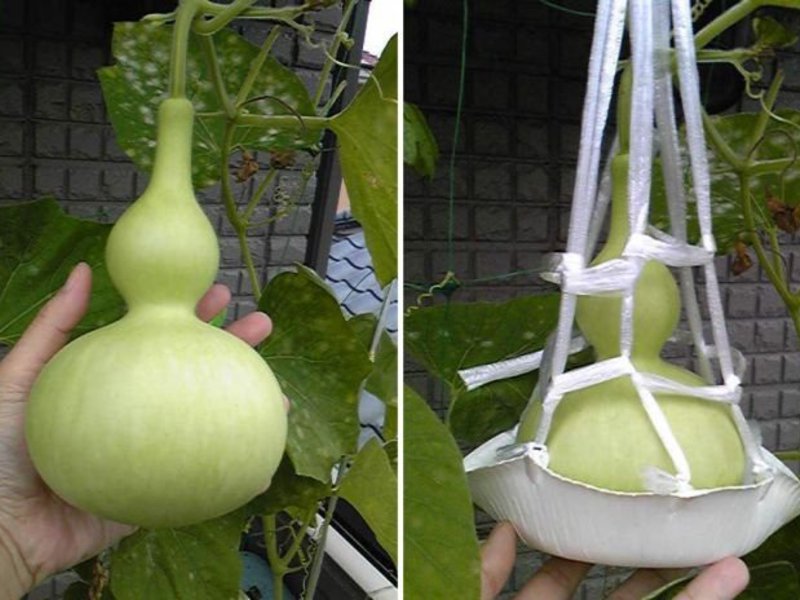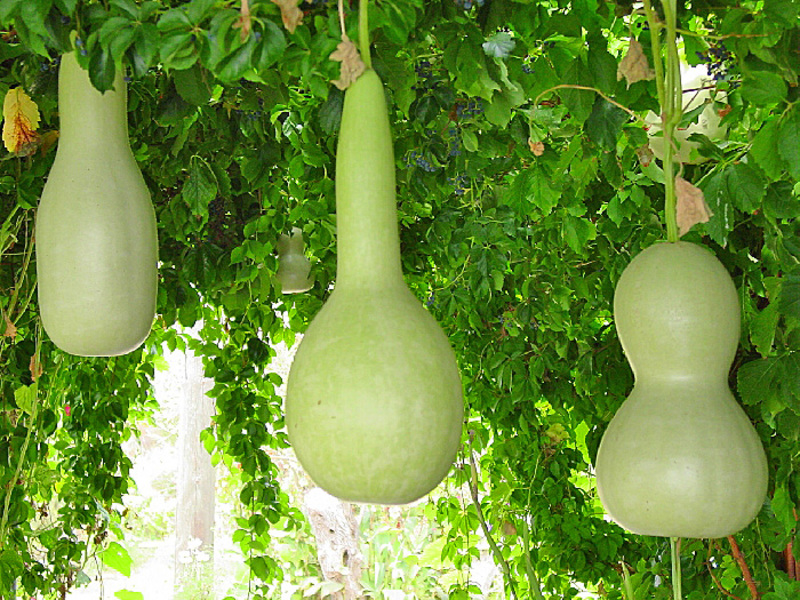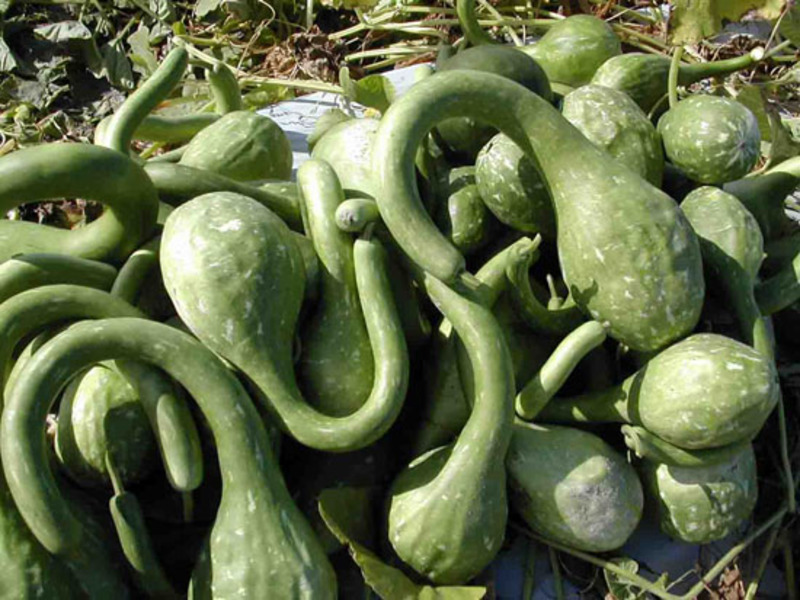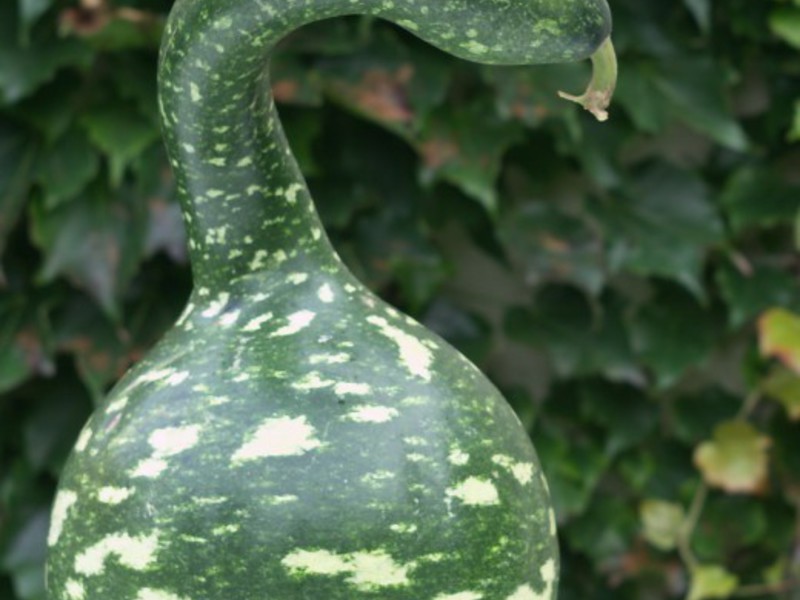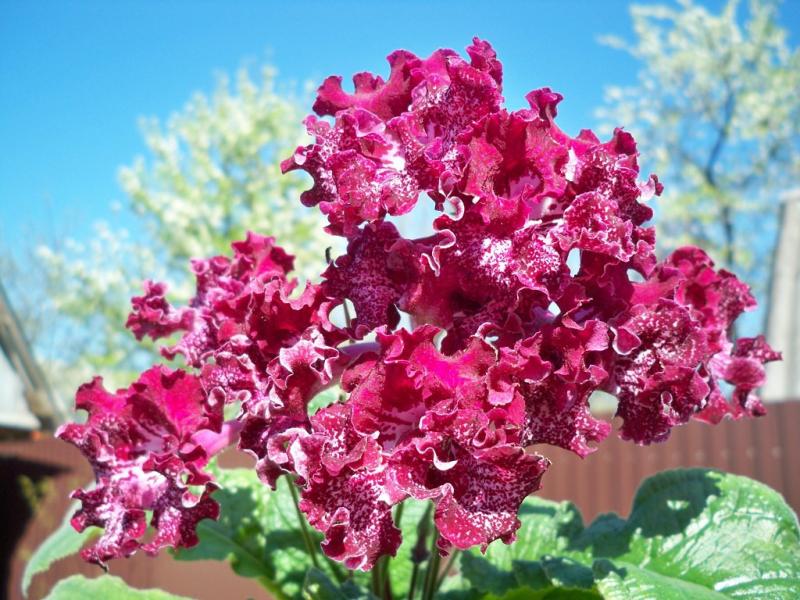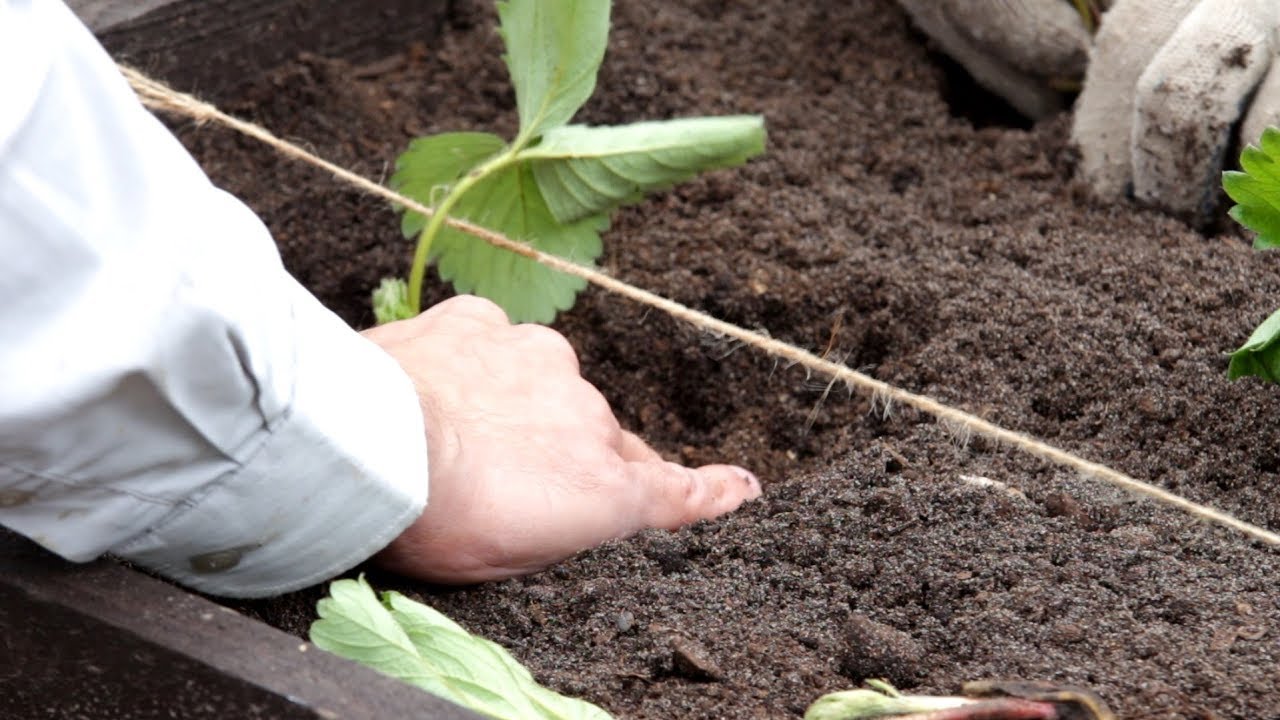Few gardeners in our country know about the amazing plant - lagenaria, and in vain. Vietnamese zucchini, Indian cucumber, serpentine lagenaria - all these are the names of one unique plant from the pumpkin family, which has been known to people since ancient times. In ancient China, he was even considered the king of all vegetables. Various vessels were made from lagenaria grown at the imperial court. It was considered a great honor to receive such an article from the hands of the Chinese emperor.
And in the countries of tropical Africa and Asia from this original vegetable to this day make ladles, bowls, mugs etc. In such a vessel, the water remains cool for a long time, and the milk does not turn sour. This is due to the fact that the peel of this pumpkin does not allow heat to pass through and is practically not exposed to microorganisms.
Content
How to use lagenaria
After looking through various photos of the Lagenaria, you can see that the plant is a climbing herbaceous vine, but the shape of the fruits is different for each variety. The most common are bottle gourds, so named due to the fact that their appearance is somewhat reminiscent of a bottle or vase.
You can use the plant in different ways:
- To eat.
- Decorate the site.
- Make unusual souvenirs and crafts.
- Use as rootstock for other pumpkin plants.
Lagenaria fruits taste good and have dietary qualities that will be appreciated by everyone who looks after their health. Young fruits are eaten like cucumbers familiar to everyone, but the best dish from Lagenaria is caviar. It is prepared according to the same recipe as the squash, but it turns out to be much tastier. And this pumpkin can be pickled, canned, and even the leaves and young stems are good for food. This plant has one unusual characteristic. Its fruits can not be cut off completely, but in parts. I wanted to eat - I cut off half a pumpkin. The remaining half will not rot, but will heal up and continue to grow.
The optimal fruit length is about 50 cm... During this period, their flesh is tender and the rind is thin. But the longer the vegetable grows and ripens, the more the tissues dry out, and the peel hardens and gradually turns into a real shell. So ripe fruits are used only for making various souvenirs, they cannot be eaten.
Dishes from Lagenaria are very useful for the body, because they contain magnesium, calcium, iron, vitamins B 1, B 2, C, PP. It is recommended to use it for diseases of the stomach, cardiovascular system, liver, bladder and kidneys. This amazing plant helps to improve metabolism, eliminate cholesterol from the body and even slow down the growth of tumors.
Decorative properties of lagenaria
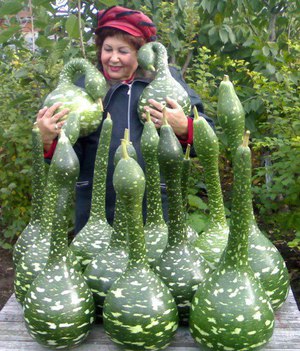 The bottle lagenaria is grown not only for the sake of the fruit. This mighty tropical vine is very beautiful and can used to decorate the site... Its leaves are large, velvety to the touch, with long petioles. Flowers are goblet and rather large. But the most interesting of all is their color: a light cream flower in the morning turns into almost white in the evening.
The bottle lagenaria is grown not only for the sake of the fruit. This mighty tropical vine is very beautiful and can used to decorate the site... Its leaves are large, velvety to the touch, with long petioles. Flowers are goblet and rather large. But the most interesting of all is their color: a light cream flower in the morning turns into almost white in the evening.
Unfortunately, they fade quickly, but in place of the fallen ones, new ones immediately appear, so the lagenaria will decorate your yard with abundant flowering until late autumn. The fruit can also be shaped to your liking by placing the ovaries in different wooden shapes. The pumpkin will grow and take on the shape you want.
Lagenaria's root system is very powerful. She quickly grows aerial and underground roots... The main root is thick and more than 80 cm long, and the lateral ones are 3 m or more. For this reason, liana is often used for rootstock when growing valuable varieties of pumpkin, watermelon or melon.
Features of growing lagenaria
Lagenaria is a native of the warm tropics, and for this reason it is very demanding on moisture, light and temperature. It is best to plant the plant in the sunniest place, reliably protected from cold winds, because even light frosts will cause irreparable harm to it. The soil should be fertile, structural, well fertilized with humus. But it is better not to plant a vegetable in acidic soil, he does not like this. The growth of lagenaria will be badly affected by the proximity of groundwater.
You need to prepare the perfect garden for a tropical guest in the fall. For this, 1 m2 lands contribute:
- 1 tablespoon potassium sulfate
- 0.5 cups of ash;
- 2 buckets of manure;
- 2 tablespoon superphosphate.
The garden bed, after making good, needs to be dug deep and thoroughly.
How to prepare seedlings
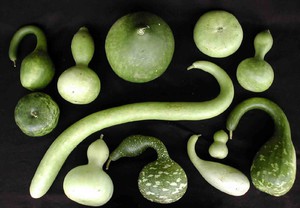 The seeds of the lagenaria are brown or light brown, rather large and have the shape of an irregular rectangle. Their peel is very hard, so before sowing they need to be soaked in hot water for half an hour, and then germinated for 2-3 days in damp sawdust or wet cloth... Some gardeners, in order to significantly accelerate seed germination, file the skin of the upper part of the seed with a file, but this must be done very, very carefully.
The seeds of the lagenaria are brown or light brown, rather large and have the shape of an irregular rectangle. Their peel is very hard, so before sowing they need to be soaked in hot water for half an hour, and then germinated for 2-3 days in damp sawdust or wet cloth... Some gardeners, in order to significantly accelerate seed germination, file the skin of the upper part of the seed with a file, but this must be done very, very carefully.
When the seeds hatch, they are planted in individual containers or nutrient cups, with a volume of about 1 liter, filled with river sand and peat mixture in a ratio of 1: 2. 2 seeds are planted in each container to a depth of approximately 2 cm. Then the future seedlings are covered with a film and hidden in a warm place. It is not recommended to plant seeds directly in open ground, as in our climate they most likely will not germinate.
With the right combination of moisture and temperature, after 10 days the plant should give its first shoots, and as soon as this happens, the film should be removed, and all the seedlings should be transferred on the sunniest windowsill... The weakest plant should be removed from each container, but not pulled out of the ground, but carefully cut with scissors. Young seedlings need to be watered regularly using only warm water. But you should not fertilize, just as you should not keep the seedlings in containers for more than 30 - 32 days, so that it does not overgrow and wear out.
Correct planting of seedlings in open ground
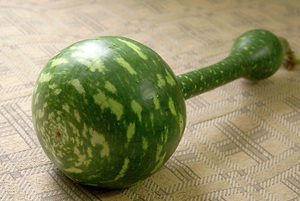 A few days before landing in open ground for lagenaria, it is time to harden. For this, the containers are taken out for a while to fresh air and open sun. When sowing seeds, it should be borne in mind that it is possible to transplant plants into open ground only when the soil warms up well, and the threat of frost will completely disappear, otherwise the lagenaria will die.
A few days before landing in open ground for lagenaria, it is time to harden. For this, the containers are taken out for a while to fresh air and open sun. When sowing seeds, it should be borne in mind that it is possible to transplant plants into open ground only when the soil warms up well, and the threat of frost will completely disappear, otherwise the lagenaria will die.
If the pumpkin has sprouted in nutrient cups, you can simply place them in small holes and lightly sprinkle with earth. But you need to take seedlings out of ordinary containers very carefully so as not to damage the sensitive root system. Lagenaria should be immersed in the ground until the cotyledonous leaves, but if the seedlings have grown and reached a height of more than 25 cm, then almost the entire stem will have to be sprinkled with soil, leaving only the top on the surface. The ground near the holes must be well pressed with your hands, and mulch with rotted compost and humus... If it is still cool at night, cover the pumpkin with boxes or plastic wrap. The ideal distance between plants is 1 m.This is quite enough for normal growth and development.
Lagenaria pumpkin does not have to be grown in a specially designated area. On the contrary, many gardeners place it near gazebos and fences. This solution gives a double benefit: firstly, there is no need to make special supports for the vines, and secondly, this is how the lagenaria decorates the site no worse than decorative climbing plants. You can plant it near an old tree, and let the whip up.
It is not difficult to take care of lagenaria further. It perfectly tolerates heat and drought, however, the growth of fruits and shoots is reduced. To avoid this, it is recommended to water the plant at least three times a week, and preferably more often. Only warm water is used for irrigation.
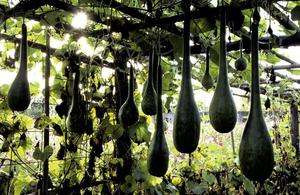 Flowers on the liana open only in the evening and are pollinated by nocturnal insects, but experienced gardeners advise not to rely on chance and pollinate the plant by hand... It's very simple. It is enough to collect pollen from the male flower with a brush or cotton swab and transfer it to the female one. The procedure should be carried out in the morning or evening.
Flowers on the liana open only in the evening and are pollinated by nocturnal insects, but experienced gardeners advise not to rely on chance and pollinate the plant by hand... It's very simple. It is enough to collect pollen from the male flower with a brush or cotton swab and transfer it to the female one. The procedure should be carried out in the morning or evening.
The resulting ovaries grow very quickly, and after two weeks they can already be eaten. If you want to get your own seeds of bottle lagenaria, then the first ovaries should be set aside and plucked just before the frost. They are kept in a warm room for a month, and in winter they saw the fruits with a hacksaw, remove the seeds, wash them, dry them and hide them in a dry place. Left to the mercy of fate, the fruits of lagenaria grow up to 2 m in length, and their weight often exceeds 7 kg... Anyone who has ever seen a vine covered with white flowers and giant bizarre bottle-shaped fruits will agree that this amazing plant is worth all the effort it took to grow it.


